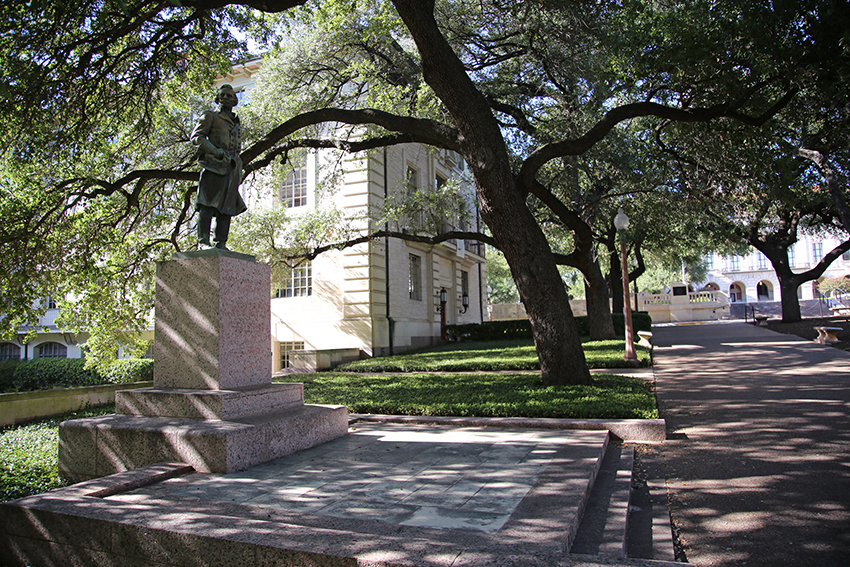The University’s last remaining Confederate monuments may have been removed from campus last week, but supporters of keeping them in place aren’t letting President Gregory Fenves off the hook that easy.
On Wednesday, a descendant of Confederate Major George Littlefield, who donated the statues to the University nearly a century ago, filed a lawsuit against Fenves in the U.S. Western District Court. The civil suit claims removing the statues is going back on the University’s agreement to uphold the “Southern perspective of American history,” one of the stipulations spelled out in Littlefield’s will and other documents in return for donations to the school.
In the will, signed in 1920, Littlefield thoroughly described how he wants his donations — which currently are valued at $500 thousand per statue, or $3 million as a group, according to the suit — to be spent.
At the time, he wanted the University to erect a “massive bronze arch over the South entrance,” where the Littlefield Fountain currently rests, with statues of several Confederate leaders sitting under the arch. Although the arch never came to fruition, the Littlefield statues that lined the South Mall depicted former Confederate leaders Jefferson Davis, Robert E. Lee, Albert S. Johnston and John Reagan, as well as Texas Gov. James Hogg and U.S. President Woodrow Wilson. A statue of U.S. President George Washington was added later in the 1950s.
Littlefield believed these statues would tell the “Southern understanding of American history and the Civil War,” according to the suit. The lawsuit claims this understanding was tarnished when Fenves removed the statues of Lee, Johnston, Reagan and Hogg, an act that abridged the petitioners’ “minority political speech.” As precedent, the suit cites the 1984 U.S. Supreme Court Case Texas v. Johnson, barring public officials from prohibiting “political speech in a public forum under its control.”
The suit’s central question is whether these statues should be displayed on campus, or if relocating them to the Briscoe Center is sufficient in upholding Littlefield’s wishes.
University and Student Government leadership have said Fenves consulted with a number of them prior to announcing the statue removal, which came in an email late Sunday night. The removal went well into the early hours of Monday morning, a move meant to prevent protests and protect students, University spokespeople said.
Student Body President Alejandrina Guzman, a government and Mexican-American studies senior, said she had been in communication with Fenves and University leadership about the statue removal since Aug. 9, less than a week before the statues came down.
“I’m proud to be a Longhorn tonight,” Guzman said at the time. “I think about all the students of color and black students who have to pass by these statues every day, and I’m proud that they are down now.”
The relocation came less than a week after a deadly protest at the University of Virginia, where a group of white supremacists fought the proposed removal of a Confederate monument depicting Lee, leaving one woman dead and several more injured. The city of Austin and several others around the country swiftly moved to take down remaining vestiges to the Confederacy, including street signs and monuments.
“These events make it clear, now more than ever, that Confederate monuments have become symbols of modern white supremacy and neo-Nazism,” Fenves said in the email.
The events in Charlottesville came years after the Davis statue was removed from campus in 2015. The Davis statue is on display in the Briscoe Center, while the other statues are waiting to be processed.
“When you put something in a museum, that’s history, that’s an artifact; you’re going in there to learn about a part of history,” government sophomore Madison Goodrich said. “Having a memorial or a monument for someone, that’s giving them power or praise, and I don’t think we should be praising proponents of slavery.”





















